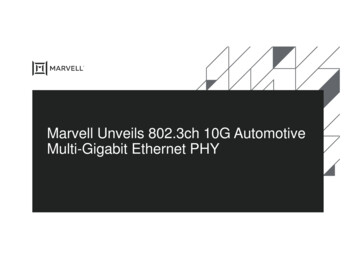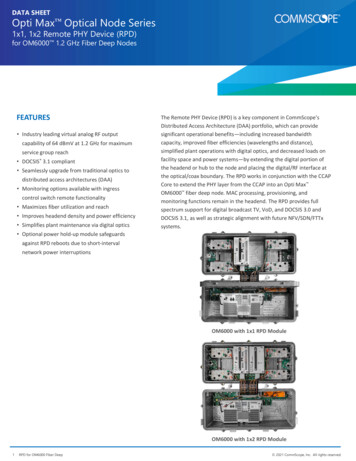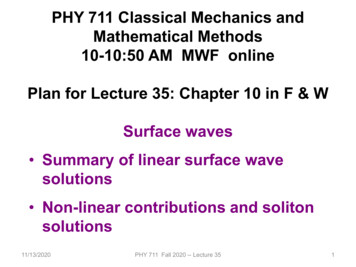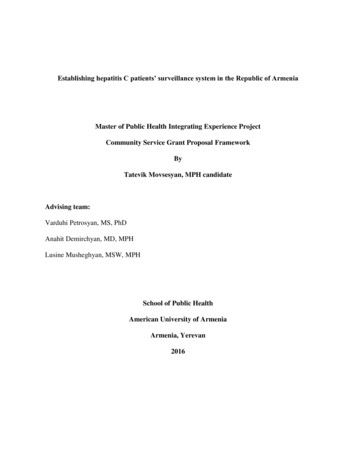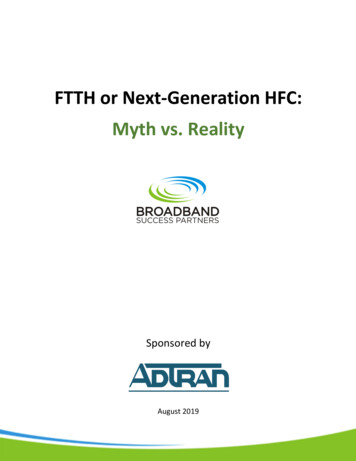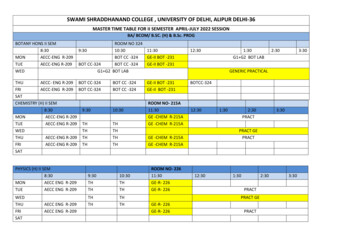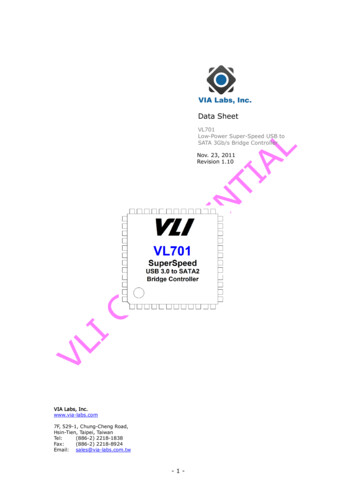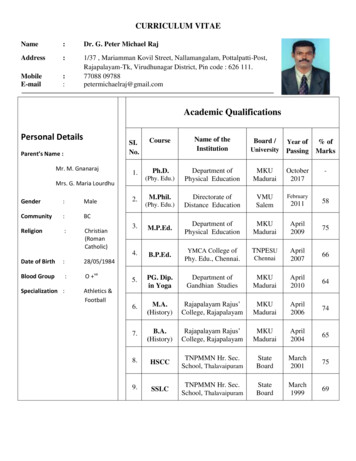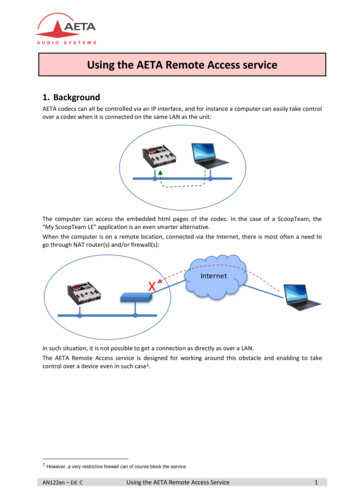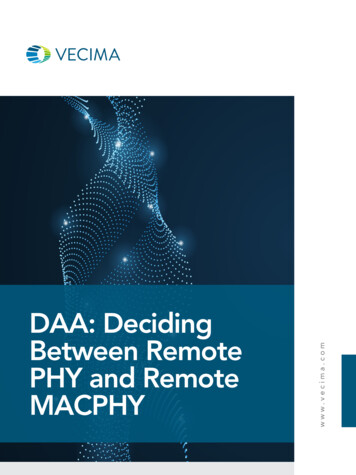
Transcription
www.vecima.comDAA: DecidingBetween RemotePHY and RemoteMACPHY
Traditional HFC Architecture Limits and DAA BenefitsAs broadband demands on operator networks continue to grow, cable operators have come to realize that the traditionalhybrid fiber coaxial (HFC) architecture – CCAP analog optics fiber nodes – is not sustainable. After decades buildingnetworks in this manner, operators are moving to a Distributed Access Architecture (DAA), pushing headend and hub functions to the node.To understand why operators are turning to DAA, we must first consider why traditional cable network architecture is reaching the end of its road. There are several inherently limiting factors, including:Limited capacityTraditional integrated CCAPs, because they depend onanalog optics, do not consistently support the higher orders of modulation used in DOCSIS 3.1 and required tomeet today’s network capacity requirements.High capital expenseThe specialized analog optics and fiber nodes used in traditional HFC networks are purchased only by cable operators. The low volume significantly drives up cost, and thelimited production results in longer lead times.High operating expenseTraditional HFC architectures and integrated CCAPs havevery high space and power requirements, the latter notjust to operate the equipment, but to keep it cool. Thesehigh-power requirements also work against the greenernetworks many operators are pursuing. Also, with manyheadends and hubs out of space, facility real estate expenses will increase.Lower customer satisfactionThe analog optics used in traditional HFC networks significantly reduce the signal-to-noise ratio (SNR) and negatively impact service quality and the customer experience. Theassociated truck rolls also increase operating expenses.DAA resolves the challenges of the traditional cable access architecture.As noted above, DAA distributes the functions typically performed in the CCAP, moving some of them from the headendto the node. There are two main variants of DAA – Remote PHY (R-PHY) and Remote MACPHY (R-MACPHY).The difference between the two variants is based on which CCAP functions get moved to the node: In R-PHY, only the DOCSIS PHY is relocated to the node In R-MACPHY, both the DOCSIS MAC and DOCSIS PHY are relocatedBy distributing these functions, DAA resolves the challenges of the traditional cable access architecture. Pushing theDOCSIS PHY to the node digitizes the entire fiber transport network, eliminating the need for analog optics, reducing theoverall capital expense and supporting more capacity via higher orders of modulation. Additionally, because RF signalsnow begin at the node instead of all the way back at the headend, DAA provides a much higher SNR, substantially boosting customers’ quality of service. Finally, because less equipment is required in the headend and hub, especially in thecase of R-MACPHY, there is a significant reduction in space and power requirements.DAA: DECIDING BETWEEN REMOTE PHY AND REMOTE MACPHY 02
DISAPPEARING RoadblocksUntil recently, obstacles including lack of standardization, unproven interoperability, and few real-world deployments tempered operators’ willingness to implement a DAA. However, as outlined in Table 1: Disappearing Roadblocks below, thesebarriers have been or are being roof CasesR-PHYR-MACPHYIt took over six years to establish a standard for RPHY. CCAP and Remote PHY Device (RPD) vendorshad to work through a multitude of architecturalchallenges. With those issues resolved, the CableLabs Remote PHY standard has delivered stabilityand enabled multi-vendor, end-to-end R-PHY solutions.The standard for R-MACPHY is CableLabs Flexible MACArchitecture (FMA). The critical FMA specifications arecomplete (See Vecima FMA Specification blog). Relying heavily on the path paved by R-PHY, R-MACPHYwas comparatively easy to specify. As the inventor ofR-MACPHY and main contributor to the FMA specification, we can confidently say that standardization is nota roadblock.Deploying best-in-class CCAP cores and RPDs together has been a major hurdle for R-PHY, but manyvendors have finally achieved interoperability. Forinstance, Vecima RPDs are fully interoperable withboth physical and virtual CCAP cores from the industry’s major vendors – Cisco, CommScope, Casa, andHarmonic. See Table 2, below, for details on VecimaRPD interoperability.The same factors that expedited FMA standardizationhave facilitated R-MACPHY interoperability. The biggest challenge for R-PHY was DOCSIS PHY/MAC interop; Remote MACPHY Devices (RMDs) have no DOCSISPHY/MAC interop requirement. Also, R-MACPHY usesthe same standardized, proven video architecture as RPHY. Furthermore, FMA uses automation and tools thatreduce the interoperability effort.R-PHY has been deployed by operators of all sizesand in all regions of the world. With numerous reference deployments, operators can be confident indeploying R-PHY.R-MACPHY has been deployed by operators of allsizes and in all regions of the world. With numerousreference deployments, operators can be confident indeploying R-MACPHY.Table 1: Disappearing RoadblocksInteroperability is an essential consideration for R-PHY deployments. To avoid finding themselves locked into a single vendor, book-ended solution, operators should plan to deploy networks using nodes sourced from different vendors than theirCCAP core.With the R-PHY specification in place, many vendorshave successfully proven interoperability. For instance,Vecima has successfully established broad interoperability between its R-PHY nodes and CCAP cores from majorvendors including Cisco, Casa, CommScope and Harmonic. In fact, as the only major supplier of DAA nodes thatdoesn’t also sell a CCAP core, we’re interop subject matterexperts. Table 2: Vecima RPD Interoperability below details Vecima’s interoperability success with these vendors.Table 2: Vecima RPD InteroperabilityComplete & ValidatedCompleteDAA: DECIDING BETWEEN REMOTE PHY AND REMOTE MACPHY 03
R-PHY vs. R-MACPHY ConsiderationsWith the benefits of DAA well defined and established, and with the roadblocks – standards, interoperability and proofcases – knocked down, the question is no longer, “Should I implement a DAA?” but “What is the best approach for mynetwork: Remote PHY or Remote MACPHY?”An operator’s decision will come down to two key considerations: 1) what are the key strategic and tactical benefitssought, and 2) which approach is better suited to their current network architecture and status?Figure 1: Key Strategic and Tactical Goals for DAAK E Y C O N S I D E R AT I O N S f o r D A AAs shown in Figure 1: Key Strategic and Tactical Goals for DAA, there are four key strategic goals associated with DAA: Improving network flexibility Increasing service velocity Maximizing network ROI Future-proofing the networkHowever, the near-term driving factors to deploy DAA today are almost always focused on the tactical benefits of costand capacity which translate into two primary goals: Increased HFC fidelity (providing additional capacity and better service quality) Greater headend density (enabling facility consolidation and reduced space and power)R-PHY addresses the HFC fidelity issue by digitizing the network all the way to the neighborhood/node. R-MACPHY alsoaddresses HFC fidelity, but additionally maximizes headend density by virtualizing the CCAP core, which in turn minimizesheadend/hub space and power requirements.When deciding between R-PHY and R-MACPHY, operators often take into consideration factors such as the degree of congestion in their headend/hub, available capacity (and therefore investment) in their existing CCAP devices, current poweruse in the outside plant, latency requirements, and their overall strategic network plan.DAA: DECIDING BETWEEN REMOTE PHY AND REMOTE MACPHY 04
R-PHY AdvantagesUsing R-PHY nodes connectede to existing CCAP devices is a smaller DAA step than R-MACPHY. It has lower perceivedrisk and offers the following benefits:Minimize operational change Takes advantage of existing headend infrastructure and architectureOperators convert existing CCAP devices to CCAP cores and replace analog optical nodes with RPDs, without changing anything upstream of the CCAPLeverage CCAP capacity and video If an operator has significant capacity remaining in its CCAP devices, this capacity will not be left fallow.If an operator has already fully integrated video into the CCAP, they can continue to take advantage of thisLower OSP power Today, an R-PHY node uses about 5% less power than an R-MACPHY nodeIn most cases, this is not a decision point, but in an environment where power and space (size of node is dependent on power) in the outside plant are very limited, R-PHY is likely the better choiceSteppingstone to R-MACPHY or FTTH R-PHY serves as an excellent first step towards R-MACPHY or, ultimately, Fiber-to-the-Home (FTTH).The near-term DAA drivers are typically focused on increased HFC fidelityand greater headend density.With Remote MACPHY, the portion of the networkbetween the headend andWith Remote MACPHY,the portion of the network between the headendand node is conventional Ethernet transport, soany DWDM or TDM system can be used. On thedown side, the equipment in each node is moreDAA: DECIDING BETWEEN REMOTE PHY AND REMOTE MACPHY 05
R-MACPHY AdvantagesR-MACPHY is a bigger step than R-PHY. It delivers almost all of the R-PHY benefits above, and in addition delivers:Smallest Headend and Hub Footprint Eliminates existing and future headend and hub equipmentMinimizes space requirements, allowing for facility reductionMinimizes power and cooling requirements (See Figure 2: Comparing Space and Power Requirements for DAAApproaches)Figure 2: Comparing Space and Power Requirements for DAA ApproachesLowest Latency (no distance limits) Ensures there are no latency issues in the network regardless of how far the node/neighborhood is from theheadendEnables hub collapses and massive centralizationGreater Network Convergence Aligns all access technologies in the outside plant – DSL, DAA, FTTH, mobile – to the same IP architecture,enabling a Converged Interconnect Network (CIN) and unified control and managementSimplifies the network architecture and allows it to flexibly align with the vision of a fully converged, multiserviceaccess networkSteppingstone to FTTH R-MACPHY is a natural waypoint in the evolution to FTTHIf you’re wondering, “Can I Use R-PHY and R-MACPHY in the same network?” the answer is,“Of course!” Some operators have even discussed using them in the same hub, using R-PHY to leverageexisting CCAP investment, and then capping and growing the network with R-MACPHY. The two technologies are fully compatible and can be transported across the same CIN network.DAA: DECIDING BETWEEN REMOTE PHY AND REMOTE MACPHY 06
Making the R-PHY and R-MACPHY DecisionSo, how should an operator ultimately choose between R-PHY and R-MACPHY?Figure 3: The Best Technology for Each SituationIt is obviously an involved decision, but to simplify things a bit:R-MACPHY delivers greater financial and operational benefits, and it is a superior strategic solution.R-PHY delivers significant benefits, requires a smaller step when deployed with an existing CCAP core andenables operators to take advantage of existing CCAP capacity.So, we suggest operators choose R-MACPHY for its greater immediate benefits - HFC fidelity, space and powersavings, low latency -- and its long-term advantages -- network flexibility.If an operator is not ready for that big of a step or if they have significant existing capacity toleverage, we suggest they choose R-PHY, which still delivers strong benefits – higher fidelity HFC and denserheadends – over the existing iCCAP architecture.What about Fiber-to-the-Home (FTTH)? FTTH has its place as well, of course. Its role today is predominantlygreenfield residential services and commercial services. FTTH has been hampered in brownfield deploymentsdue to legacy video, but is growing as operators move to IP video. We will address FTTH in another whitepaper.Both approaches deliver strong financial, operational and strategic benefits. If you are unsure which approachis the best fit for your network or specific network situation, Vecima is ready, willing and able to assist you in afull evaluation.DAA: DECIDING BETWEEN REMOTE PHY AND REMOTE MACPHY 07
Victoria Vancouver Saskatoon AtlantaDuluth Raleigh Sunnyvale LondonAmsterdam Tokyo Qingdao ShanghaiPhone: 1.306.955.7075Email: sales@vecima.comw w w. v e c i m a . c o mCopyright Vecima Networks Inc.
to the node. There are two main variants of DAA - Remote PHY (R-PHY) and Remote MACPHY (R-MACPHY). The difference between the two variants is based on which CCAP functions get moved to the node: In R-PHY, only the DOCSIS PHY is relocated to the node In R-MACPHY, both the DOCSIS MAC and DOCSIS PHY are relocated
